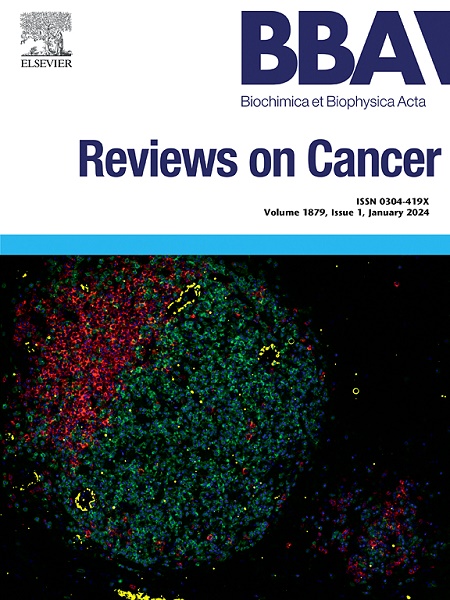Intricate role of DRP1 and associated mitochondrial fission signaling in carcinogenesis and cancer progression
IF 9.7
1区 医学
Q1 BIOCHEMISTRY & MOLECULAR BIOLOGY
Biochimica et biophysica acta. Reviews on cancer
Pub Date : 2025-09-16
DOI:10.1016/j.bbcan.2025.189453
引用次数: 0
Abstract
The process of mitochondrial fission is a major determinant of mitochondrial homeostasis. DRP1 is the chief architect of the mitochondrial fission process, and the DRP1 recruitment to the mitochondrial outer membrane is necessary for the mitochondrial division. DRP1 contributes to cancer progression by promoting cell proliferation, enhancing resistance to therapy, inhibiting apoptosis, suppressing immune responses, and sustaining cancer stem cell heterogeneity and self-renewal. Moreover, DRP1 drives metabolic reprogramming to support enhanced energy production and biosynthesis required for tumor growth and survival. In addition, DRP1-mediated mitochondrial fission also favours NLRP3 inflammasome activation within the tumor microenvironment, which regulates cancer progression. Interestingly, elevated levels of DRP1 expression have been identified as a significant prognostic marker, correlating with poor survival outcomes across multiple cancer types. Many DRP1 inhibitors have been developed for cancer treatment, but more specific and selective agents are needed to improve efficacy and reduce off-target effects. A comprehensive understanding of DRP1's role in cancer cells is essential for developing DRP1 inhibitors, which hold promise as novel anticancer therapies and may enhance the effectiveness of conventional treatments.

DRP1和相关线粒体裂变信号在癌变和癌症进展中的复杂作用。
线粒体分裂过程是线粒体稳态的主要决定因素。DRP1是线粒体分裂过程的总设计师,DRP1募集到线粒体外膜是线粒体分裂的必要条件。DRP1通过促进细胞增殖、增强对治疗的抵抗力、抑制线粒体介导的细胞凋亡、抑制免疫反应、维持癌症干细胞的异质性和自我更新来促进癌症的进展。此外,DRP1驱动代谢重编程,以支持肿瘤生长和生存所需的增强能量生产和生物合成。此外,drp1介导的线粒体分裂也有利于肿瘤微环境中NLRP3炎性体的激活,从而调节癌症的进展。有趣的是,DRP1表达水平升高已被确定为一个重要的预后标志物,与多种癌症类型的不良生存结果相关。许多DRP1抑制剂已被开发用于癌症治疗,但需要更多的特异性和选择性药物来提高疗效并减少脱靶效应。全面了解DRP1在癌细胞中的作用对于开发DRP1抑制剂至关重要,DRP1抑制剂有望成为新的抗癌疗法,并可能提高常规治疗的有效性。
本文章由计算机程序翻译,如有差异,请以英文原文为准。
求助全文
约1分钟内获得全文
求助全文
来源期刊

Biochimica et biophysica acta. Reviews on cancer
医学-生化与分子生物学
CiteScore
17.20
自引率
0.00%
发文量
138
审稿时长
33 days
期刊介绍:
Biochimica et Biophysica Acta (BBA) - Reviews on Cancer encompasses the entirety of cancer biology and biochemistry, emphasizing oncogenes and tumor suppressor genes, growth-related cell cycle control signaling, carcinogenesis mechanisms, cell transformation, immunologic control mechanisms, genetics of human (mammalian) cancer, control of cell proliferation, genetic and molecular control of organismic development, rational anti-tumor drug design. It publishes mini-reviews and full reviews.
 求助内容:
求助内容: 应助结果提醒方式:
应助结果提醒方式:


